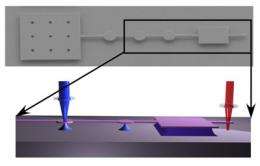Sensitive nano oscillator can detect pathogens

(PhysOrg.com) -- By watching how energy moves across a tiny device akin to a springing diving board, Cornell researchers are a step closer to creating extraordinarily tiny sensors that can instantly recognize harmful substances in air or water.
The researchers, led by professor of applied and engineering physics Harold Craighead, made a device just 200 nanometers thick and a few microns long with an oscillating cantilever hanging off one end. (A nanometer is one-billionth of a meter; a micron is one-millionth of a meter.) They identified exactly how to tune its sensitivity -- a breakthrough that could lead to advanced sensing technologies.
The experiments detailed online Feb. 8 in Journal of Applied Physics show how these oscillators, which are nanoelectromechanical systems (NEMS), could one day be made into everyday devices by lining up millions of them and treating each cantilever with a certain molecule.
"The big purpose is to be able to drive arrays of these things all in direct synchrony," said first author Rob Ilic, a research associate at the Cornell NanoScale Science and Technology Facility. "They can be functionalized with different chemistries and biomolecules to detect various pathogens -- not just one thing."
The cantilever is like a diving board that resonates at distinct frequencies. In past research, the team has demonstrated that by treating the cantilever with different substances, they can tell what other substances are present. For example, E. coli antibodies attached to the cantilever can detect the presence of E. coli in water.
The researchers have perfected the oscillators' design, Ilic said, by laying their device on top of a layer of silicon dioxide, all of which rest on a silicon substrate. A pad with holes connects pegs of silicon dioxide, lined up like telephone poles, which eventually end at the cantilever.
A laser beam, switched on at the far end from the cantilever, travels down the device and causes the oscillator to wobble. The frequency is then measured by shining another laser on the oscillator and noting patterns in the reflected light.
The "telephone poles" allow the energy to move efficiently across the device by preventing it from buckling or sagging. The design makes it easy to read the resonant frequency of the cantilever.
In this process, the researchers discovered that over short distances, the energy from the laser came in the form of heat, which quickly dissipates. But when the laser was parked hundreds of microns away from the cantilever, the energy came in the form of acoustical waves that traveled through the device, dissipated more slowly, and allowed them to make their device longer.
Provided by Cornell University



















